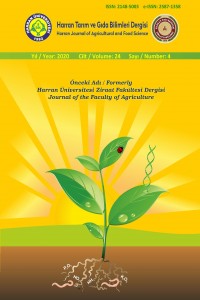Öz
With this research, individual and operational characteristics of pepper producers in Sanliurfa province were examined and the factors that are effective in adopting good agricultural practices (GAP) were tried to be determined. In this research, the data obtained by conducting face-to-face questionnaires were analyzed with 90 producers producing Şanlıurfa pepper in Şanlıurfa province. According to the results of the analysis, it was determined that a significant number of pepper-producing operators were graduates of primary schools (37.78%) and secondary schools (24.44%). In this research, it was found that they produced vegetables in 35.39% of the farm land. It was determined that all pepper producers had not done GAP and 44.45% were not even aware of GAP. Among the reasons manufacturers do not make GAP is the first place to not know the application criteria (25.50%). Manufacturers lack information due to insufficient publication studies related to GAP. GAP is supported by the state in the cultivation of fresh fruits and vegetables under cover and greenhouses. Other important reasons for not implementing it were lack of infrastructure (25.20%) and insufficient state support (24.60%). Şanlıurfa pepper producers need the necessary infrastructure to produce within the scope of GAP. In this research, the relations between agricultural activities, environmental health and human health are sufficiently aware. Şanlıurfa pepper will be produced within the scope of GAP as a geographically marked product and its reliability will increase. The export potential of isot, obtained from the pepper produced, will also increase.
Anahtar Kelimeler
Good agricultural practices Pepper production Awareness level Geographically marked product
Proje Numarası
19127
Kaynakça
- AKBAY. C., BOZ. İ., TİRYAKİ.G.Y., CANDEMİR. S. ve ARPACI. B. B., (2012). Kahramanmaraş ve Gaziantep illerinde kırmızıbiberin üretim yapısı ve kurutma yöntemleri. Kahramanmaraş Sütçü İmam Üniversitesi Doğa Bilimleri Dergisi. 15(2): 1-10.
- ANONİM, (2018a). http://www.ecas.com.tr/iyi-tarim-uygulamalari-nedir. (Erişim tarihi:24.07.2018)
- ANONİM, (2018b). https://www.tarim.gov.tr/Konular/Tarimsal-Destekler/Alan-Bazli-Destekler/Iyi-Tarim-Uygulamalari-Destegi. (Erişim tarihi:24.07.2018)
- ANONİM, (2019c). Şanlıurfa’nın Tescilli Lezzetleri. http://www.medyaurfa.com/gundem/urfa-nin-cografi-isaretli-urunleri-dijital-ortamda-h77628.html (Erişim tarihi: 26.07.2019)
- AYTOP. Y. ve AKBAY. C., (2018). Maraş Biberi Üretim Memnuniyetinin Yapısal Eşitlik Modeliyle Belirlenmesi. KSÜ tarım ve Doğa Dergisi. 21(5): 725-737. 2018.
- CTR. 2019. http://belgelendirme.ctr.com.tr/iyi-tarim-uygulamalarinin-faydalari.html. (Erişim Tarihi:11.07.2019) GÜLER. D., https://cografiisaretli.com/tag/cografi-isaretli. 18 MART 2018. (Erişim Tarihi:12.07.2019)
- KAN. M. ve GÜLÇUBUK. B., (2008). Kırsal Ekonominin Canlanmasında ve Yerel Sahiplenmede Coğrafi İşaretler. U. Ü. Ziraat Fakültesi Dergisi. Cilt 22. Sayı 2. 57-66. https://dergipark.org.tr/tr/download/article-file/154078 (Erişim tarihi: 25.10.2019)
- KARADAŞ. K., (2017). Şanlıurfa İlinde Koyunculuk İşletmelerinin Sosyo-Ekonomik Durumu: Siverek İlçesi Örneği. GÜFBED/GUSTIJ (2017) 7 (2): 268-279 Araştırma/Research https://dergipark.org.tr/tr/download/article-file/328781 (Erişim Tarihi: 27.09.2019)
- TUİK, (2019). https://biruni.tuik.gov.tr/medas/?locale=tr (Erişim tarihi: 03.07.2019)
- YAMANE. T., (1967). Elementery Sampling Theory Prentice. Hall Inc. Englewood Cliffs. N.J. . USA
Öz
Anahtar Kelimeler
İyi tarım uygulamaları Biber üretimi Farkındalık düzeyi Coğrafi işaret
Destekleyen Kurum
HÜBAK
Proje Numarası
19127
Kaynakça
- AKBAY. C., BOZ. İ., TİRYAKİ.G.Y., CANDEMİR. S. ve ARPACI. B. B., (2012). Kahramanmaraş ve Gaziantep illerinde kırmızıbiberin üretim yapısı ve kurutma yöntemleri. Kahramanmaraş Sütçü İmam Üniversitesi Doğa Bilimleri Dergisi. 15(2): 1-10.
- ANONİM, (2018a). http://www.ecas.com.tr/iyi-tarim-uygulamalari-nedir. (Erişim tarihi:24.07.2018)
- ANONİM, (2018b). https://www.tarim.gov.tr/Konular/Tarimsal-Destekler/Alan-Bazli-Destekler/Iyi-Tarim-Uygulamalari-Destegi. (Erişim tarihi:24.07.2018)
- ANONİM, (2019c). Şanlıurfa’nın Tescilli Lezzetleri. http://www.medyaurfa.com/gundem/urfa-nin-cografi-isaretli-urunleri-dijital-ortamda-h77628.html (Erişim tarihi: 26.07.2019)
- AYTOP. Y. ve AKBAY. C., (2018). Maraş Biberi Üretim Memnuniyetinin Yapısal Eşitlik Modeliyle Belirlenmesi. KSÜ tarım ve Doğa Dergisi. 21(5): 725-737. 2018.
- CTR. 2019. http://belgelendirme.ctr.com.tr/iyi-tarim-uygulamalarinin-faydalari.html. (Erişim Tarihi:11.07.2019) GÜLER. D., https://cografiisaretli.com/tag/cografi-isaretli. 18 MART 2018. (Erişim Tarihi:12.07.2019)
- KAN. M. ve GÜLÇUBUK. B., (2008). Kırsal Ekonominin Canlanmasında ve Yerel Sahiplenmede Coğrafi İşaretler. U. Ü. Ziraat Fakültesi Dergisi. Cilt 22. Sayı 2. 57-66. https://dergipark.org.tr/tr/download/article-file/154078 (Erişim tarihi: 25.10.2019)
- KARADAŞ. K., (2017). Şanlıurfa İlinde Koyunculuk İşletmelerinin Sosyo-Ekonomik Durumu: Siverek İlçesi Örneği. GÜFBED/GUSTIJ (2017) 7 (2): 268-279 Araştırma/Research https://dergipark.org.tr/tr/download/article-file/328781 (Erişim Tarihi: 27.09.2019)
- TUİK, (2019). https://biruni.tuik.gov.tr/medas/?locale=tr (Erişim tarihi: 03.07.2019)
- YAMANE. T., (1967). Elementery Sampling Theory Prentice. Hall Inc. Englewood Cliffs. N.J. . USA
Ayrıntılar
| Birincil Dil | Türkçe |
|---|---|
| Konular | Tarım Politikaları |
| Bölüm | Araştırma Makaleleri |
| Yazarlar | |
| Proje Numarası | 19127 |
| Yayımlanma Tarihi | 16 Aralık 2020 |
| Gönderilme Tarihi | 19 Mayıs 2020 |
| Yayımlandığı Sayı | Yıl 2020 Cilt: 24 Sayı: 4 |
Cited By
Türkiye'de İyi Tarım Uygulamalarının Değerlendirilmesi: Fındık Üreticilerinden Bir Bakış
Bursa Uludağ Üniversitesi Ziraat Fakültesi Dergisi
https://doi.org/10.20479/bursauludagziraat.1004486
Üreticilerin İyi Tarım Uygulamalarına Yaklaşımı ve Uygulamaların Benimsenmesini Etkileyen Faktörler: Mersin İli Örneği
Türk Tarım ve Doğa Bilimleri Dergisi
Osman UYSAL
https://doi.org/10.30910/turkjans.872363
Derginin Tarandığı İndeksler
Harran Tarım ve Gıda Bilimi Dergisi, Creative Commons Atıf –Gayrı Ticari 4.0 Uluslararası (CC BY-NC 4.0) Lisansı ile lisanslanmıştır.


